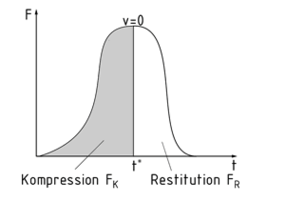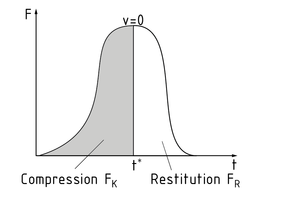
Choose one
or multiple languages
0,1,1
- German
- English
- Chinese
- Spanish
Compression period

The compression period is the time it takes for a body to be deformed following an impact. The time required for this body to return to its exact or near-original state is called the restitution period. The Force F acting during the impact is at its maximum at the end of the compression period ${{t}^{*}}$ and decreases to zero over the restitution period. The impacted body is static at the transition point between compression and restitution, which means that $v=0$.
In the case of an ideal elastic impact (coefficient of restitution $e=1$), restitution is a mirror image of the compression, because no energy is lost due to plastic deformation. An ideal plastic impact_x000B_($e=0$) simply consists of a compression period.
The graph in the diagram illustrates a partially elastic impact $(0
Kompressionsperiode

Die Kompressionsperiode entspricht dem Zeitintervall, den ein Körper zur Verformung infolge eines Stoßvorganges benötigt. Das Zeitintervall, in dem sich dieser Körper wieder in seinen Ausgangszustand oder beinahe in diesen zurückformt, wird als Restitutionsperiode bezeichnet. Die während des Stoßvorganges wirkende Kraft F ist am Ende der Kompressionsperiode ${{t}^{*}}$ maximal und nimmt über die Restitutionsperiode auf null ab. Der gestoßene Körper befindet sich beim Übergang der Kompression in die Restitution in Ruhe, sodass $v=0$ gilt.
Liegt ein ideal-elastischer Stoß (Stoßzahl $e=1$) vor, verläuft die Restitution spiegelbildlich zur Kompression, weil keine Energie durch Plastische Verformung abgeführt wird. Ein ideal-plastischer Stoß ($e=0$) besteht nur aus einer Kompressionsperiode.
Der in der Abbildung gezeigte Graph bildet den Ablauf eines teilelastischen Stoßes $(0
压缩期

压缩期 是指物体承受冲击后变形所需要的时间。物体恢复到初始状态或接近初始状态所需时间称为恢复期。冲击时的 作用力F 在压缩期 ${{t}^{*}}$ 结束时达到最大值,在恢复期逐渐减小至零。被冲击的物体在压缩期和恢复期的转变点处保持静止,也就意味着 $v=0$ 。
在理想弹性冲击状态下 (恢复系数 $e=1$ ), 恢复行为与压缩行为呈镜像关系, 这是由于在塑性变形过程中没有能量的损失。理想的塑性冲击( $e=0$ )仅包含压缩期。
图中曲线呈现了部分弹性冲击过程 $(0
部分弹性冲击过程的压缩与恢复
Periodo de compresión

El periodo de compresión es el tiempo que le toma a un cuerpo deformarse después de un impacto. El tiempo requerido para que este cuerpo regrese a su estado exacto o cercano al original se llama periodo de restitución. La fuerza F que actúa durante el impacto está en su punto máximo al final del periodo de compresión ${{t}^{*}}$ y disminuye a cero durante el periodo de restitución. El cuerpo impactado está estático en el punto de transición entre la compresión y la restitución, lo que significa que $v=0$.
En el caso de un impacto elástico ideal (coeficiente de restitución $e=1$ ), la restitución es una imagen de espejo de la compresión, ya que no se pierde energía debido a la deformación plástica. Un impacto plástico ideal ( $e=0$ ) simplemente consiste en un periodo de compresión.
La gráfica en el diagrama ilustra un impacto parcialmente elástico $(0
Compresión y restitución de un impacto parcialmente elástico
